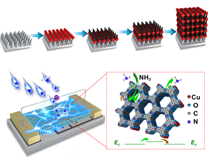Electronic conductive metal–organic frameworks (EC-MOFs) possess both good electronic conductivity and regular porosity, which show great potential applications in electrical devices including field-effect transistor (FET), supercapacitor, chemiresistor gas sensor, etc. However, EC-MOFs based high performance devices have been limited to date by a lack of high quality thin film.
In a study published in Angew. Chem. In. Ed., the research group led by Prof. XU Gang from Fujian Institute of Research on the Structure of Matter (FJIRSM) of the Chinese Academy of Sciences (CAS) reported the controllable thin film fabrication of an EC-MOF, Cu3(HHTP)2, (HHTP=2,3,6,7,10,11-hexahydroxytriphenylene), by a spray layer-by-layer liquid-phase epitaxial method. The Cu3(HHTP)2 nanofilms can be precisely prepared with controllable thickness, smooth surface, good crystallinity and high orientation.
The –OH functionalized substrate was used to orient the thin films growth. The Cu3(HHTP)2 nanofilms with different thickness can be well controlled by varing growing cycles. As confirmed by SEM and AFM results, the thickness increment and roughness of the nanofilm can be precisely controlled by ~2 nm per growing cycle and less than 5 nm, respectively.
In addition, selected area electron diffractions (SAED) of the nanofilm fragments peeled off from Cu3(HHTP)2 nanofilms were consistent with the hexagonal crystal structure (a = b = 21.75 Å, c = 6.66 Å). The c-axis orientation structure feature can be observed by the missing rings of (00l) and existing rings of (hk0).
The above results indicate the successful preparation of high quality EC-MOFs with controlled thickness in nanometer scale, smooth surface, good crystallinity and high orientation. As a typical application on electrical devices, Cu3(HHTP)2 nanofilms grown on sapphire substrates with Au interdigital electrodes (room temperature (RT) conductivity, 0.02 S cm-1) were directly used as NH3 RT chemiresistor gas sensor.
The sensor exhibited the typical behaviour of a p-type semiconductor with good response-recovery properties, repeatability (the coefficient of variation 1.54%) and long-term stability (retention of 88.4% after 3 months). The response of Cu3(HHTP)2 (20 nm) toward 100 ppm NH3 was estimated to be 129%, which is ~12 times higher than that of the reported sensors based on Cu3(HHTP)2 powders or nanorods.
Notably, this response value is among the highest ones of the reported RT sensors. Moreover, good selectivity of 4.55-8.25 (S = Response (NH3)/ Response (gas)) of NH3 toward different reducing gas was observed, which is good enough for precise detection of NH3 among these interfering gases.
The typical peaks for NH3-Cu, as well as the red shift of n(C=O) and n(C-O) in IR spectra, suggested strong interactions between NH3 and Cu3(HHTP)2, which might contribute to its high selectivity. The up-shift Fermi level observed by ultraviolet photoelectron spectroscopy (UPS) measurements showed a typical n-type doping after NH3 adsorption. It is consistent with increasing resistance of the sensor toward reducing NH3.
The nanofilm (<100 nm) of Cu3(HHTP)2 not only provides short gas diffusion length and high ratio of accessible surface area, but also facilitates effective charge transport because of its high crystallinity and large single crystal domain size. All of these contribute to its high sensing performances.

Schematic representation of the preparation of Cu3(HHTP)2 nanofilm gas sensors.(Image by Prof. XU’s Group)
Contact:
Prof. XU Gang
Fujian Institute of Research on the Structure of Matter
Chinese Academy of Sciences
Email: gxu@fjirsm.ac.cn